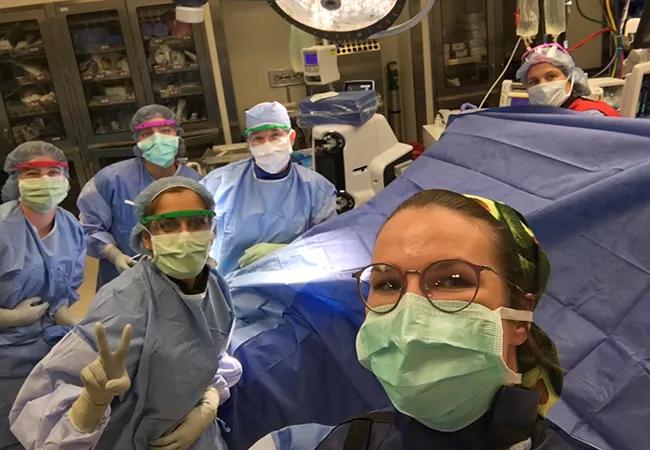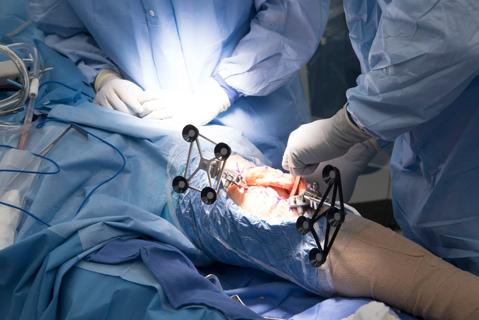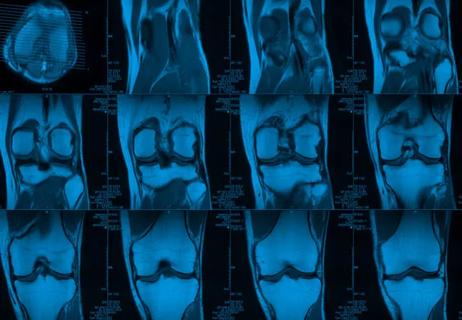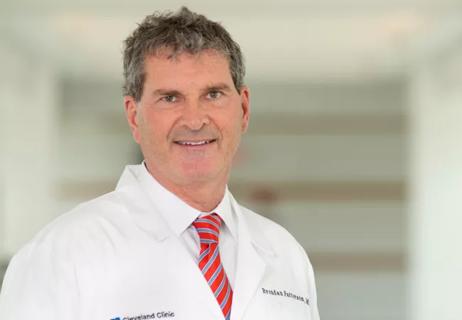Diversifying the specialty starts with earlier exposure for female students

Orthopaedic surgeon Sara Lyn Miniaci-Coxhead, MD, determined her career early in life. At age 12, she accompanied her orthopaedic surgeon father to a university career fair and spent the day playing with a knee scope, thoroughly fascinated. In medical school, after briefly considering family medicine, she focused on orthopaedics, acknowledging her affinity for working with her hands and realizing that her “happy place” was in the operating room.
Cleveland Clinic is a non-profit academic medical center. Advertising on our site helps support our mission. We do not endorse non-Cleveland Clinic products or services. Policy
“When my mentor in med school took me into the OR to help with a total hip replacement for the first time, I thought it was amazing,” she says. “I knew it was what I wanted to do for the rest of my life.”
That early exposure to and mentorship in orthopaedics isn’t common for young women, says Dr. Miniaci-Coxhead, a foot and ankle specialist at Cleveland Clinic. And that may be part of the reason that only about 6% of practicing orthopaedic surgeons today are female. Orthopaedic surgery has the lowest representation of female physicians of any medical specialty.
“Nearly half of all med students today are female, yet only 14% of orthopaedic residents are,” says Dr. Miniaci-Coxhead. “That’s an indication that orthopaedics is losing women to other specialties. We’re missing out on all those bright minds that could help bring diverse ideas and maybe new innovations to our field.”
For this reason, since 2018 Cleveland Clinic has hosted events to introduce young women in high school or medical school to careers in orthopaedic surgery. The annual events are sponsored by The Perry Initiative, an organization working to inspire young women to become leaders in orthopaedic surgery and engineering. The organization is named in honor of orthopaedic pioneer and gait analysis expert Jacquelin Perry, MD, one of the first women certified by the American Board of Orthopaedic Surgery.
Dr. Miniaci-Coxhead attended her first Perry Initiative event in 2015, during her residency at University of Rochester. In 2018 she brought the program to Cleveland Clinic.
“When I joined Cleveland Clinic in 2016, I was the only female member of the orthopaedics faculty,” she says. “There had been one other before me, and now there are four. But I felt that I was in a unique position to promote women in orthopaedics, and the department was very supportive of hosting Perry Initiative events.”
More than 60 students attended Cleveland Clinic’s events this year, in October. Medical students attended one of two evening programs. High school students attended a full-day Saturday event. All events were at no cost to participants.
Events included presentations on how to become an orthopaedic surgeon and how to maintain work-life balance. During typical in-person events, students get hands-on experience with drills and other equipment and work with bone models in simulated surgeries. Orthopaedic surgeon volunteers walk around the room, interacting with students and explaining biomechanical principles. For this year’s events — held virtually due to the COVID-19 pandemic — students participated in online labs, such as reviewing X-rays and selecting the placement of screws to fix a fracture.
The goal of Perry Initiative events is to introduce more girls and women to the possibility of a career in orthopaedic surgery.
Why don’t more women become orthopaedic surgeons? That’s a common question and the topic of much research, says Dr. Miniaci-Coxhead. It may be that orthopaedics isn’t well represented in the first years of medical school, and often isn’t a mandatory rotation like general surgery and some surgical specialties.
“Then there’s the stereotype — that you need to be a big, muscular athlete to do ortho. That isn’t true,” says Dr. Miniaci-Coxhead. “There’s also a misconception that orthopaedic surgery careers aren’t favorable for work-life balance. Physicians who want to manage both family and career may be deterred from choosing the specialty.”
The American Academy of Orthopaedic Surgeons, as well as Cleveland Clinic, is working to correct those myths, she says. So are organizations like The Perry Initiative and Nth Dimensions, which is helping introduce more women and underrepresented minorities to careers in the field.
And maybe females just need to see other females in the role, adds Dr. Miniaci-Coxhead.
“My dad had a physician colleague who was a woman,” she says. “I’m sure that seeing her as an orthopaedic surgeon somehow helped me believe that I could be one too.”
Dr. Miniaci-Coxhead, who is part of the orthopaedic residency selection committee at Cleveland Clinic, helps keep diversity foremost. Currently eight of Cleveland Clinic’s 30 orthopaedic surgery residents (27%) are female.
As for recruiting more well-qualified women to the orthopaedic staff, Dr. Miniaci-Coxhead says female-friendly employee policies go a long way.
“Cleveland Clinic’s 12-week maternity leave made having my third child much easier,” she says. “I could put my practice on hold and then come back after my leave and hit the ground running. It is possible for orthopaedic surgeons to have whatever type of family life they prefer.”
Even if the population of female orthopaedic surgeons doesn’t grow exponentially, more women should be encouraged to consider the career, she stresses.
“We don’t want women to think of orthopaedic surgery as only a man’s job,” says Dr. Miniaci-Coxhead. “Yes, it’s a physical job, but it takes finesse and knowledge of biomechanics.”
It’s also a rewarding career that can greatly improve patients’ quality of life, she adds.
“I love helping someone who had debilitating pain become able to run after their grandkids again,” she says. “That is so satisfying. And, surprisingly, orthopaedic surgeons do have long-term patient relationships. Patients come back — like if I repaired an ankle on one side and now they have a bunion on the other — or they refer their friends and family members.”

New digital tool allows parents to self-schedule fracture care for their children

Improvements in patient care, research and education set the stage for a promising future

Orthopaedic team launches the MATTER program

The longitudinal study will examine long-term risk factors for osteoarthritis after ACL injury

Introducing Brendan M. Patterson, MD

Study examines pre- and postoperative benefits

The short answer from Orthopaedic Surgery Chairman Michael A. Mont, MD

Review of nearly 10,000 patients yields data on ideal effective dose for lowest risk of complications